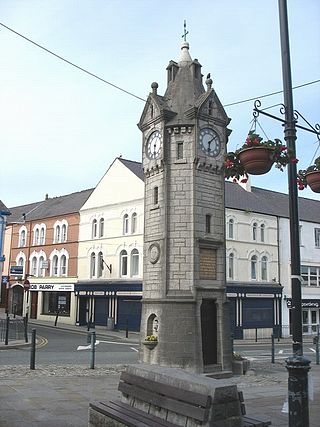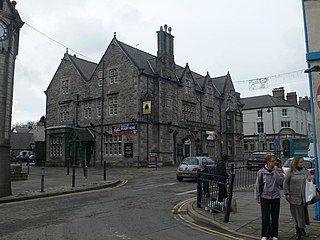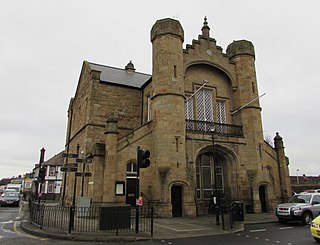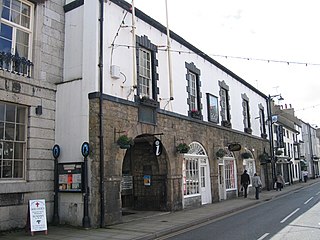
Llangefni is the county town of Anglesey in Wales and contains the principal offices of the Isle of Anglesey County Council. The 2011 census recorded Llangefni's population as 5,116 people, making it the second-largest settlement in the county and the largest settlement on the individual island. The community includes the village of Rhosmeirch.

The Isle of Anglesey County Council is the local authority for the Isle of Anglesey, a principal area with county status in Wales. Since 2022 the council has 35 councillors who represent 11 multi-member electoral wards.

The Isle of Anglesey is a county off the north-west coast of Wales. It is named after the island of Anglesey, which makes up 94% of its area, but also includes Holy Island and some islets and skerries. The county borders Gwynedd across the Menai Strait to the southeast, and is otherwise surrounded by the Irish Sea. Holyhead is the largest town, and the administrative centre is Llangefni. The county is part of the preserved county of Gwynedd.

The Bull Hotel is a Grade II-listed building in Llangefni, Anglesey, built during the nineteenth century in a seventeenth-century vernacular style. It replaced an earlier inn built on the same site.

The Shire Hall is a municipal building in Fore Street, Hertford, the county town of Hertfordshire, England. The building, which currently serves as a Magistrates' Court, is a Grade I listed building.

Llangefni Town Hall is a civic building dating back to the mid 19th-century, in the town of Llangefni, Anglesey, Wales. It is a Grade II listed building.

Pontypool Town Hall is a municipal structure in Hanbury Road, Pontypool, Wales. The town hall, which forms the original part of a civic centre that now serves as the headquarters of Torfaen County Borough Council, is a Grade II listed building.

Llandudno Town Hall is a municipal structure in Lloyd Street, Llandudno, Wales. The town hall, which serves as the meeting place of Llandudno Town Council, is a Grade II listed building.

Maesteg Town Hall is a municipal structure in Talbot Street, Maesteg, Wales. The town hall, which was the headquarters of Masteg Borough Council, is a Grade II listed building.

Flint Town Hall is a municipal structure in the Market Square, Flint, Flintshire, Wales. The town hall, which is the meeting place of Flint Town Council, is a Grade II listed building.

The Shire Hall is a municipal structure in the High Street, Haverfordwest, Pembrokeshire, Wales. The shire hall, which was the meeting place of the old Pembrokeshire County Council, is a Grade II* listed building.

The Shire Hall is a municipal structure in Broad Street, Presteigne, Powys, Wales. The building incorporates a well-preserved courtroom and a museum known as "the Judge's Lodging". Once the judicial centre for Radnorshire, is a Grade II* listed building.

Sandown Town Hall is a municipal building in Grafton Street, Sandown, Isle of Wight, England. The structure, which was the meeting place of Sandown Urban District Council, is a Grade II listed building.

Holyhead Town Hall is a municipal structure in Newry Street, Holyhead, Wales. The town hall is the meeting place of Holyhead Town Council.

Mold Town Hall is a municipal structure in Earl Road in Mold, Wales. The town hall, which serves as the meeting place of Mold Town Council, is a Grade II listed building.

Beaumaris Town Hall is a municipal building on Castle Street, in Beaumaris, Anglesey, Wales. The structure, which is the meeting place of Beaumaris Town Council, is a Grade II listed building.

The Old Town Hall is a municipal building in Old Market Street, Usk, Monmouthshire, Wales. The structure, which is now used as the local club of the Royal British Legion, is a Grade II listed building.

Fishguard Town Hall is a municipal building in the Market Square, Fishguard, Pembrokeshire, Wales. The structure, which is the meeting place of Fishguard and Goodwick Town Council, is a Grade II listed building.

Pembroke Town Hall is a municipal building in Main Street, Pembroke, Pembrokeshire, Wales. The structure, which is the meeting place of Pembroke Town Council, is a Grade II listed building.

Bangor Town Hall, formerly The Bishop's Palace, is a municipal building on Ffordd Deiniol, in Bangor, Gwynedd, Wales. The structure, which is now used as a museum, is a Grade II listed building.






















